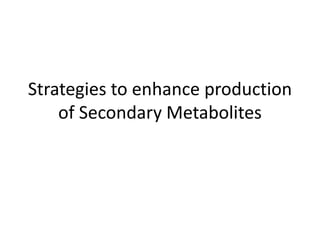
Strategies to enhance production of secondary metabolites
- 1. Strategies to enhance production of Secondary Metabolites
- 2. Strategies to enhance production of Secondary Metabolites • Screening of high-growth cell lines to produce secondary metabolite of interest – Cell line selection • Use of elicitors to enhance productivity in a short period of time • Adsorption of metabolites to overcome feed back inhibition • Scale-up of cell cultures in suitable bioreactors • Immobilization of cells to enhance yields of extra- cellular metabolites and to facilitate biotransformation • Use of Organ Cultures – Hairy Root cultures • Permeabilization of secondary metabolites to recovery or downstream processing
- 4. Plant cell culture is a genetically heterogeneous system. In addition, epigenetic changes cause genetic instability leading to product accumulation only in some population of cells. The overall production of secondary metabolites in a cell culture depends on the rate of accumulation within the productive cells. By cell culture system only low yields of desired secondary metabolites are obtained. The reason for low production in culture may be due to: Competition between primary and secondary pathways for common intermediates Low levels of expression of key enzymes at rate limiting steps in a pathway Screening is a passive technique by which a great number of cells alone analyzed for a certain traits and those showing the desired features are cultivated and screened. Selection process is an active process, which deliberately favor only the survival of the desired variants while wild type cells are killed. 1. Selection of cell lines with high productivity
- 5. 1. Selection of cell lines with high productivity • Identify a genotype with high levels of desired secondary metabolite • Callus from such a genotype serves as the source of desirable cell lines • Screening for Selection of cell lines with high productivity • Screening for high yielding lines for coloured compounds like shikonin, berberine and betain is easy – most coloured cell clumps can be isolated and cultured separately • Cells with highly fluorescent metabolites/compounds can be detected using UV microscope, Flowcytometry • HPLC and RIA are also used to screen high yielding cell lines • Selected cell lines should be stable, repeated selection process would ensure isolation of true variant cell line
- 6. • Two methods followed: • 1. Single cell cloning - Single cells are taken from suspension cultures and grown into population. • 2. Cell aggregate cloning- Cell aggregates are separated from suspension cultures and plated on solid medium and cultured. Selection of cell lines with high productivity
- 7. 1. Selection of cell lines with high productivity Cell line selection in Panax sikkimensis root callus cultures
- 8. 2. Use of elicitors to enhance productivity of secondary metabolites • In nature plants produce many compounds in response to biotic and abiotic stresses • Stress due to pathogen infection or exposure adverse physical conditions enhance the production of secondary metabolites. • The phenomenon of accumulation of secondary metabolites in response to biotic or abiotic stress conditions is known as Elicitation. • The compounds or agents which induce elicitation are called Elicitors.
- 9. Elicitors • Elicitors can be either biotic or non-biotic in nature. • Biotic elicitors: • Fungal extracts or toxins • Bacterial extracts or toxins • Culture filterates • Compounds obtained from microbial cell walls – polysaccharids, glycoproteins, chitosons etc. • Yeast extracts • Abiotic elicitors: Physical and chemical agents • UV radiation • Exposure cold or heat • Ethylene • Fungicides • Antibiotics • Heavy metal salts • High Salt concentration
- 10. Mechanism of Elicitation • Elicitors bind to the receptors present on the plasmamembrane and trigger signal transduction and activating enzymes involved in production of secondary metabolites. • Elicitor induced products are continuously released in to medium. • This allows continuous production of secondary metabolites.
- 11. Factors affecting Elicitation • Sensitivity of the cell cultures • Specificity of elicitors • Concentration of elicitors • Timing and duration of elicitor exposure to culture medium • Most of the cells respond to elicitors only during growth phase
- 12. 3. Immobilization of Cells • In suspension cultures plant cells grow faster and produce less secondary metabolite. • Cell aggregates have better ability to produce & accumulate secondary metabolites than free floating suspensions. • It is essential to anchor the plant cells on some support or entrap the cell in a matrix such as gel, agar, alginate, polyacrylamide etc. • Such a process of anchoring plant cell is known as Immobilization. • Brodelius et al. (1979) first reported the immobilization of C. roseus and Daucus carota cells by entrapping them in alginate beeds.
- 13. Steps in Immobilization Process • Preparing a support – substantially uniform and porous matrix of inorganic material • Introducing culture of viable plant cells into the pores of matrix • Entrapping the plant cells by coating the matrix with a solution or colloidal suspension not interfering with the cell viability • Immobilizing the entrapped cells within the matrix with a reactive gas .
- 17. Permeabilization of secondary metabolites • Many secondary metabolites are hydrophilic, so they are primarily stored in the cell vacuole. • Hydrophobic molecules are often stored in the cell membrane, vesicles, dead cells and extracellular sites, such as the cell wall. • By manipulating the permeability of cell membrane, they can be secreted out to the media. • Permeabilisation can be achieved by electric pulse, UV, pressure, sonication, heat, etc. • To maintain cell viability and allow for further use of biomass, cells can be permeabilized using pH shock or chemical treatments like DMSO.
- 18. Production of secondary metabolites using Hairy Roots
